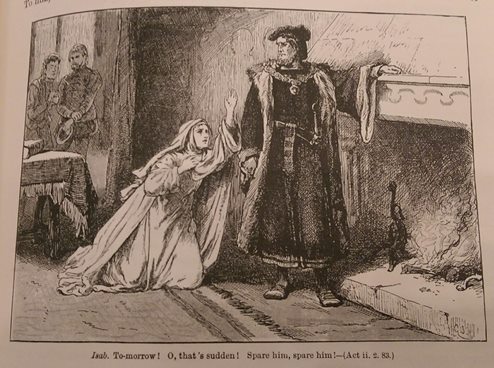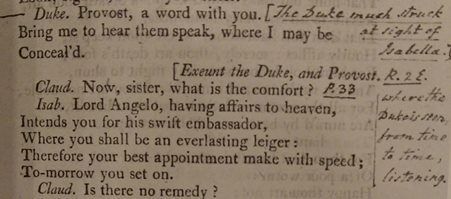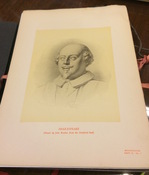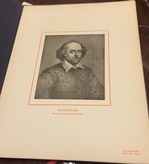Hello!
My name is Pieter, and I’m part of this summer’s CCEPS-SURP program. (SURP stands for Summer Undergraduate Research Program, which is Pomona College’s primary summer research program for students). A little about me –I came to Claremont from the East Coast, and I’m a Religious Studies major with a particular interest in intersections of Christianity and political theory (and politics in general), out of which I will likely form a concentration.
I am one of three students spending the majority of our summers working in Special Collections’ vast expanse of Shakespeare materials, particularly in the Philbrick Collection. We could post about anything from major Shakespearean directors’ handwritten letters to curiously censored 19th-century editions of Shakespeare’s plays.
I spent most of last week studying Measure for Measure and searching for any interesting materials housed in Special Collections that might shed some light on this play and its history. Today I want to share with you to some of the work of John Philip Kemble, an important 18th-century actor and manager
I found my way to Kemble’s work through an edition of Shakespeare’s Measure for Measure that Kemble published in 1803. Kemble’s edition has his own cuts and changes for stage, as it was performed at Drury Lane in London in the 1790s. It allows a unique opportunity, then, to see just how this production handled what can be a rather opaque character, the Duke of Vienna.
Measure for Measure centers on the impending execution of Claudio, who is guilty of fornication on something of a technicality. He has been condemned by Angelo, the Duke of Vienna’s deputy, as the Duke has supposedly left town. Claudio’s sister Isabella goes to Angelo to plead for Claudio’s life; he tells her that she can have her wish if she will give him her virginity. Isabella, a nun-to-be, decides to let her brother die rather than sacrifice her chastity. Angelo’s power over the situation, however, is a farce, as the Duke never left Vienna to begin with, and instead disguises as a friar and plays a few tricks to make sure the story comes to a happy end.

Through the Duke’s machinations we learn that Angelo is even more a villain than we thought, and when the Duke returns in the final act and pretends to hear of the situation for the first time, he deigns it best that Angelo be executed for his wrongdoing. But Isabella and Angelo’s betrothed Mariana (to whom Angelo has done much wrong) plead for his life, and the Duke instead decides that Angelo will simply marry Mariana.
This easy way out for Angelo is surprising given the nature of Angelo’s offenses and the rather brief development of his repentance, and gives the play what some describe as a “disturbing effect.” Moreover, it is unclear at first glance why the Duke didn’t simply exert his powers as Duke from the start rather than using subterfuge.
How does this involve Kemble? I spent some time looking at a facsimile of Kemble’s own promptbook, which was a printing of his edition with handwritten notes giving stage directions and diagrams. Here, I found some stage directions that may have attempted to explain the Duke’s motives. The Duke, in both the original text and Kemble’s, asks for Isabella’s hand in marriage at the end of the play, after Claudio is revealed alive and Angelo and Mariana renew their betrothal. But in Kemble’s edition, an early scene between the Duke (disguised as a friar) and Isabella are made to foreshadow this event. Kemble writes that the Duke is “much struck at the sight of Isabella” from the moment he first sees her.

In this production, then, it is established from the beginning that the Duke is interested in Isabella. Perhaps the heightened drama that the Duke’s slow manipulation of events provides is not only to increase audience tension, but serves to swoon Isabella. This fits well with the Duke’s strategy in Shakespeare’s text:
“I will keep her ignorant of her good [Claudio’s survival],
To make her heavenly comforts of despair
When it is least expected.” (Act IV Scene 3)
This plan has no romantic connotation, but if one wants to interpret the Duke as Isabella’s suitor all along, it would serve as an effective guiding principal for the Duke’s actions. The Duke’s advice to Isabella that she not “stain [her] gracious person” when Angelo makes his offer takes on a perhaps more selfish tone (though I would not suspect that is what Kemble intended), as the Duke is essentially asking Isabella to preserve her chastity for himself at Claudio’s mortal expense. Indeed when Isabella chastises Claudio for asking her to give herself up to Angelo, Kemble’s stage directions have the duke enter between them, as if shielding Isabella from her brother’s crude plea.
That’s all for this week! I leave you with the gorgeous 1889 cover of The Henry Irving Shakespeare, vol. V from which the above illustration was taken:






